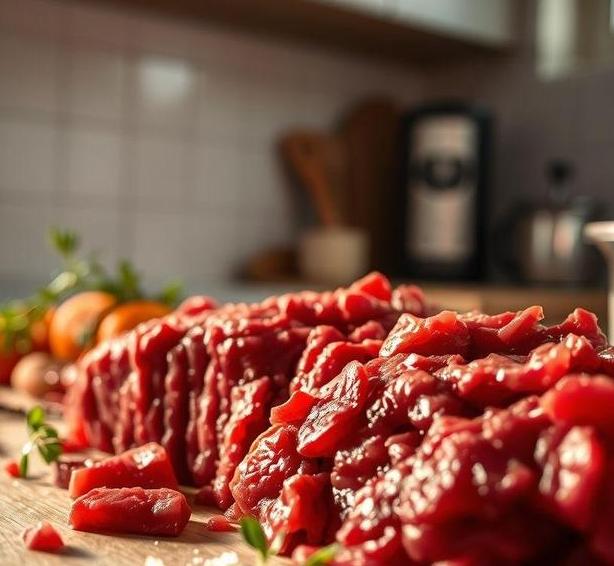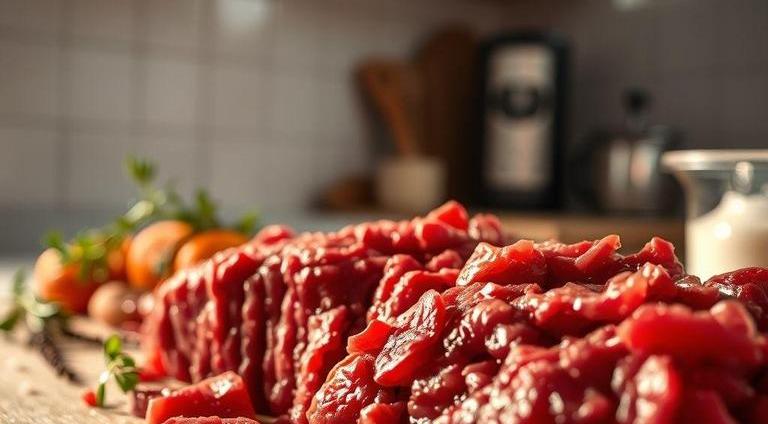Minced beef is one of the most versatile and widely used ingredients in kitchens around the world. Whether it’s made into juicy burgers, savory meatballs, or tender bolognese, minced beef is a go-to for home cooks and chefs alike. But as convenient and tasty as it is, minced beef, like any other perishable food, doesn’t last forever. The key to enjoying it safely is knowing how to store it properly, recognizing the signs of spoilage, and understanding its shelf life.
In this guide, we’ll explore all the important aspects of minced beef, from its shelf life to the best practices for storing it and identifying when it’s gone bad. This information can help you make the most of this pantry staple while ensuring food safety in your kitchen.
Can Minced Beef Go Bad?
Absolutely. Minced beef, being a highly perishable product, can go bad if not stored or handled correctly. Because it’s ground, it has a larger surface area compared to whole cuts of beef, which means bacteria can penetrate and multiply more quickly. Additionally, if it’s left out at room temperature for too long or stored improperly, it can spoil rapidly. It’s essential to know what to look for to avoid consuming spoiled minced beef, as it can lead to food poisoning and other unpleasant consequences.
Shelf Life For Minced Beef

The shelf life of minced beef varies depending on how it’s stored and whether it’s fresh or cooked. Here’s a breakdown:
Fresh Minced Beef (Uncooked)
- Refrigerator: When stored in the fridge, fresh minced beef should ideally be used within 1 to 2 days. The cold temperature slows bacterial growth, but it doesn’t stop it completely.
- Freezer: If you’re not planning on using the minced beef within that time frame, freezing it is your best option. Minced beef can stay fresh for 3 to 4 months in the freezer without significant loss of quality. After that, it’s still safe to eat, but its taste and texture may begin to degrade.
Cooked Minced Beef
- Refrigerator: Once minced beef is cooked, it can last a bit longer in the fridge, typically 3 to 4 days. Be sure to store it in an airtight container to preserve its freshness.
- Freezer: If you want to keep it for a longer period, cooked minced beef can be stored in the freezer for 2 to 3 months. Just make sure it’s properly cooled before freezing and packed well to prevent freezer burn.
Common Signs Of Spoilage
Knowing how to spot bad minced beef is key to avoiding foodborne illnesses. Here are the main signs to look out for:
- Smell: One of the most obvious indicators of spoiled minced beef is a sour or off-putting smell. Fresh minced beef should have a clean, slightly metallic scent, while spoiled beef will smell rancid or foul, similar to rotten eggs or ammonia.
- Color: Fresh minced beef is typically a bright red color, though it can darken slightly over time due to exposure to oxygen. However, if the beef turns a brownish or grayish hue, it’s starting to spoil. While color changes don’t always mean the beef is bad, it’s a red flag to consider.
- Texture: When minced beef begins to spoil, it will lose its firm texture and become slimy or sticky to the touch. This is a clear sign of bacterial growth. Fresh minced beef should be firm and moist but not slimy.
- Appearance of Mold: This is a less common sign, but if you notice any green, white, or black mold on the surface of the minced beef, it’s definitely no longer safe to consume.
How To Store Minced Beef?

Proper storage is the key to extending the shelf life of minced beef and keeping it safe to eat. Here’s how you can store it to maintain its freshness:
-
Refrigeration
- Always store minced beef in the coldest part of your fridge, ideally at temperatures between 32°F and 40°F (0°C to 4°C).
- If you bought minced beef from a store, keep it in its original packaging unless you need to transfer it to an airtight container or resealable bag.
- If the minced beef has been opened, you should use it within 1-2 days and ensure it is well-sealed to prevent contamination.
-
Freezing
- To freeze minced beef, wrap it tightly in plastic wrap, aluminum foil, or place it in a freezer-safe bag or container. Make sure you remove as much air as possible to avoid freezer burn.
- You can also divide it into smaller portions before freezing to make it easier to thaw only what you need.
- Be sure to label the packaging with the date so you can keep track of how long it’s been in the freezer.
-
Thawing
- When you’re ready to use frozen minced beef, it’s best to thaw it in the refrigerator overnight. Avoid defrosting it at room temperature, as this can promote bacterial growth.
- If you need it quicker, you can use the microwave or cold water thawing method, but these can affect the texture slightly, so plan accordingly.
Expert Tips
To keep your minced beef fresh and avoid spoilage, here are a few pro tips:
- Buy Fresh: When purchasing minced beef, always check the sell-by or use-by date, and try to buy it as fresh as possible. If it’s on sale or nearing its expiration, try to freeze it immediately to avoid wasting it.
- Avoid Overhandling: Ground beef is more susceptible to contamination, so handle it as little as possible. Use clean utensils and hands, and make sure to cook it thoroughly to kill any bacteria present.
- Cook Before Freezing: If you plan to freeze minced beef, consider cooking it first. This way, you’re not just freezing raw meat, but already-prepared meals like chili, taco filling, or spaghetti sauce, which can be a big time-saver later on.
- Trust Your Senses: If in doubt, trust your senses. Don’t hesitate to throw out minced beef if it smells or feels off. It’s better to be cautious than risk food poisoning.
FAQs
How Long Can Minced Beef Stay Fresh In The Refrigerator?
Minced beef can stay fresh in the refrigerator for 1 to 2 days. If you don’t plan on using it within this time frame, it’s best to freeze it to maintain its quality.
How Can You Tell If Minced Beef Has Gone Bad?
Signs that minced beef has gone bad include a sour or rancid smell, a slimy texture, and a change in color, usually turning brown or gray. If any of these signs are present, it’s best to discard it.
Can Minced Beef Go Bad If It’s Frozen?
While freezing minced beef can extend its shelf life, it can still go bad if stored for too long. Frozen minced beef is best used within 3 to 4 months for optimal quality, though it can be safe to eat for up to 6 months.
What Temperature Should Minced Beef Be Stored At To Avoid Spoiling?
Minced beef should be stored at a temperature of 40°F (4°C) or lower to prevent bacterial growth. If left at room temperature for more than 2 hours, it should be discarded.
Is It Safe To Eat Minced Beef Past The Expiration Date?
It is not recommended to eat minced beef past its expiration date. While the beef may still be safe, it could have a compromised texture and flavor. Always check for signs of spoilage before consuming.
Can Minced Beef Go Bad In The Freezer?
Yes, minced beef can go bad in the freezer if stored improperly or for too long. While freezing it can help preserve it for months, freezer burn or improper sealing can cause the meat to deteriorate in quality.
How Long Can Minced Beef Be Kept In The Freezer Before It Goes Bad?
Minced beef can be safely stored in the freezer for 3 to 4 months. While it won’t spoil immediately after this period, its texture and flavor may degrade over time.
What Are The Risks Of Eating Bad Minced Beef?
Eating bad minced beef can lead to foodborne illnesses such as salmonella, E. coli, or listeria, which can cause symptoms like nausea, vomiting, abdominal pain, and diarrhea. It’s important to discard any meat showing signs of spoilage.
Can You Cook Minced Beef That Is Slightly Discolored Or Has A Mild Odor?
It’s generally not recommended to cook minced beef that is discolored or has an off smell. While cooking may kill some bacteria, the risk of foodborne illness increases, and the meat’s quality will be compromised.
Can You Store Minced Beef In The Fridge If It Has Been Left Out For A Few Hours?
If minced beef has been left out at room temperature for more than 2 hours, it should be discarded. Bacteria can multiply quickly in the temperature danger zone (between 40°F and 140°F), making the meat unsafe to consume.